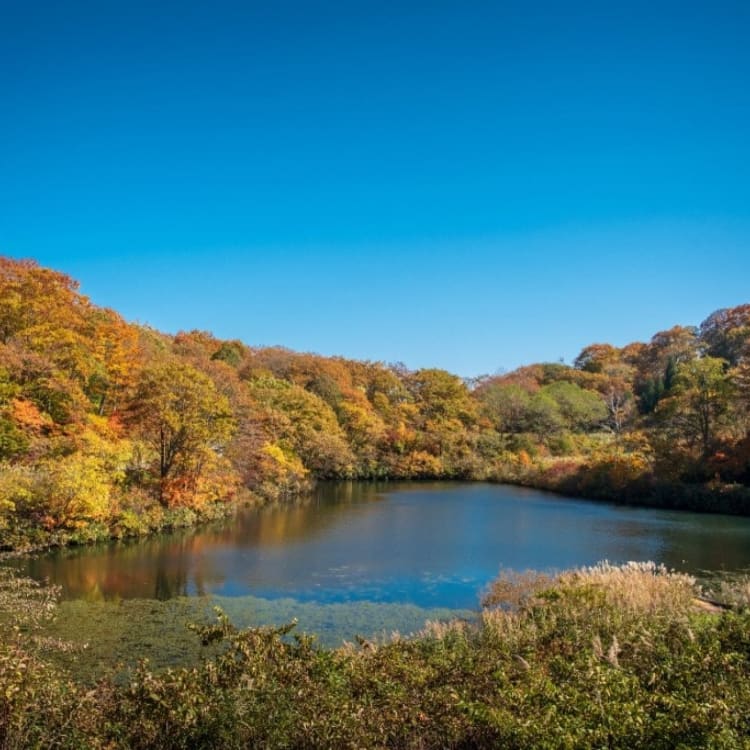
An Insider’s Guide to the Shinetsu Trail Diverse landscapes and untouched nature await in this hiker’s paradise
While Japan is known for its buzzing, skyscraper-populated cities, its countryside is abundant with incredible, unspoiled landscapes. And one of the best ways to experience this is by exploring one of Japan's many hiking trails.
Today, we’re introducing the Shinetsu Trail, an untouched, 110km-long trail that runs along the Sekida Mountain Range on the border between Nagano and Niigata Prefectures. It passes through small villages, farmlands and beech forests, and offers an insight into how Japan’s natural beauty intersects with everyday regional life.
To learn more about this well-kept local secret, we spoke to Yukiko Sato of the Shin-etsu Trail Club , a club dedicated to helping visitors from Japan and across the world discover its wonders and Sahori Shibata, of the Shinshu-Iiyama Tourism Bureau (the Shinetsu Trail sits within the Shinshu-Iiyama region). Together, they offered insights into the best time to visit the Shinshu-Iiyama region, the region's local specialties and what makes the Shinetsu Trail so special.
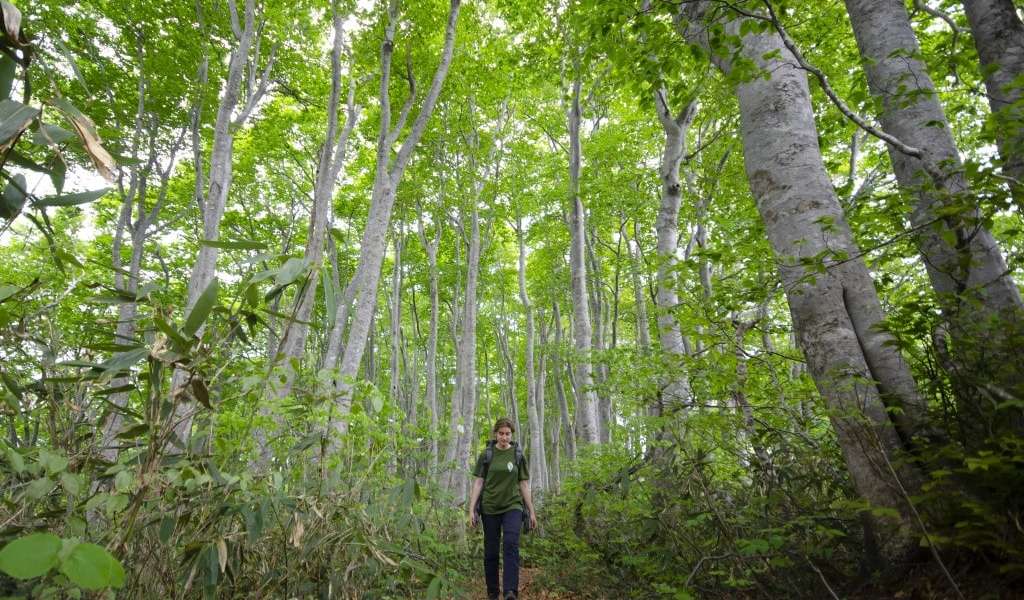
Section 4 of the trail, underneath the beech trees
Can you tell us a bit about how you got this job and what inspired you to become a guide?
My [Yukiko Sato’s] love of the Shinetsu Trail comes thanks to the work of backpacker, hiker and author, Noriyoshi Kato. His work exploring and writing about the Shinetsu Trail in 2016 captured my attention, and I became fascinated with the trail.
What do you think makes the Shinetsu Trail so special?
So many things! It’s an area that often experiences heavy snowfall in winter and being deep in nature and admiring the landscape during this type of weather is very special.
The trail also showcases Japanese satoyama landscapes, which are quite unique to Japan. The term 'satoyama' in Japanese can be broken down into two words ‘sato’ where people live and ‘yama’ the mountains. Essentially ‘satoyama’ areas are countryside communities where locals have lived for centuries farming, managing and caring for the land and the mountains. It’s a quaint, rural side of Japan and an example of sustainable living.
One of the attractions of walking the Shinetsu Trail is that you can take in the trail at a pace that does the region justice. We always recommend taking your time to explore the unique topography of areas like the Sekida Mountains and the foothills of Mt Naeba, which offer truly inspiring views.
Lastly, the community aspect of the trail is something very special. The trail is cared for and managed by volunteers who work together to maintain it. These volunteers come from all over the country to help develop and support the Shinetsu Trail and the surrounding region.

Section 2 of the trail, Numanohara
What are some things that international travellers should be prepared for when hiking the Shinetsu Trail?
The hiking season for the Shinetsu Trail runs from June to November. But, there are a few things to know depending on when you’re hiking:
- Mid-June to early July is the wet season, so, if hiking during this time, rain gear (raincoats and umbrellas) is a must.
- In summer (late July to mid-August), Japan can be very hot and humid (even more so than in countries like Australia). If hiking during this time, be sure to bring enough water and food.
Additionally, some sections of the trail (5-6) have quite a lot of inclines and declines and other sections (7-9) are on paved roads. So, if your knees aren’t the best you might want to bring knee support.
What do you always bring when walking the Shinetsu Trail?
If you can carry it, always bring an umbrella. This is for two reasons: firstly, with the exception of a portion of section 10, the trail passes below where the trees grow, an area with high rainfall and humidity, so it’s often too hot to wear a raincoat. Secondly, an umbrella will also provide sun protection when walking on the paved trail in sections 7-9.
What level of fitness is needed to take on the Shinetsu Trail?
The physical fitness required depends on the section of the trail you’re walking. This means that folks of all fitness levels can enjoy the trail, which is fantastic. That said, it is worth mentioning that it's not a flat trail, so those who have at least a little hiking experience and who are confident in their fitness will get the most out of the trail.
The below chart outlines the different sections of the trail and their difficulty levels, for a better idea of what to expect.
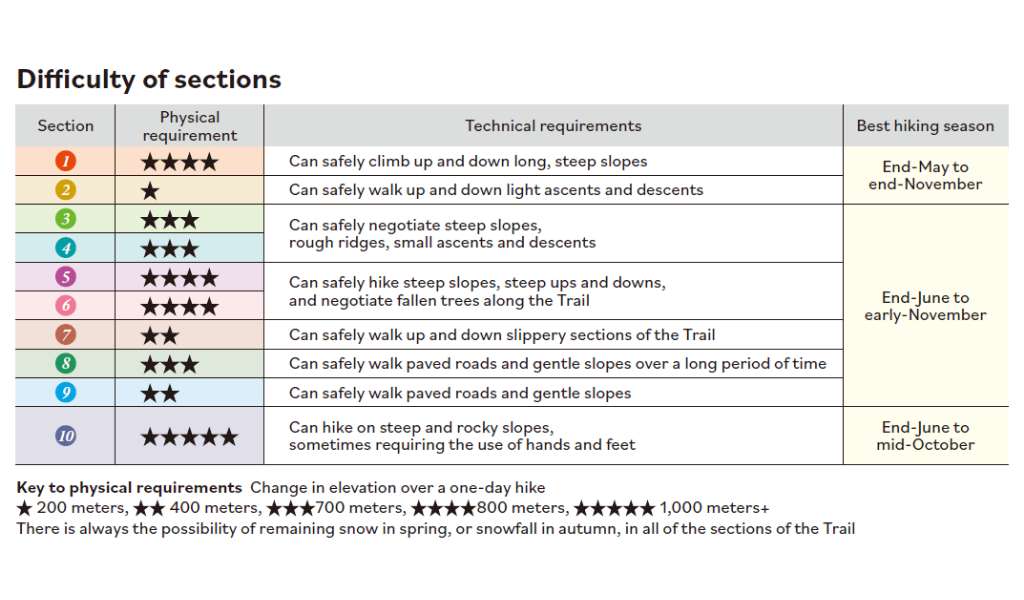
Is there a particularly good time to visit the area?
The best time to visit is in autumn (from the end of September to mid-October). The weather isn't too hot or cold during this time, making it ideal for trail walking. Autumn colours, known as koyo in Japanese, typically peak in October and the views of the colourful leaves are spectacular during this time of year.
What are the areas/courses/sections of the trail that you would recommend to international travellers and how long would you recommend spending on them?
We would recommend that travellers walk all sections of the Shinetsu Trail if they can - each section has its own charms and offers incredibly diverse landscapes.
If you have the time and plan to walk at a leisurely pace, we advise taking about ten days and nine nights (one section per day). But, for those visiting from overseas, we understand that a ten-day hike might not be possible! If you don’t have quite that much time, you can also enjoy hiking sections of the trail.
Here's a breakdown of the trail’s different sections to better understand how visitors might experience it.
- Sections 1 - 3: these cover the Takao Plateau and the southern part of the Sekida Mountains. Walking in the highlands and marshlands, it's a course where you can experience the area's history and culture.
- Sections 4 - 6: these cover the northern part of the Sekida Mountains and take you through a deep beech forest (it’s the perfect place to lose yourself in).
- Sections 7 - 9: these sections travel through the villages that surround the Shinshu-Iiyama area, like Sakae and Akiyamago.
- Section 10: this is the most challenging section and is best for those with a high level of physical fitness. It includes a 2,000-metre climb in Naeba and occasional rocky slopes.
For those who want a more casual approach, the best way to explore the trail is to pick and choose a selection of day hikes to do over a few days, taking on sections that match your personal fitness levels and interests.
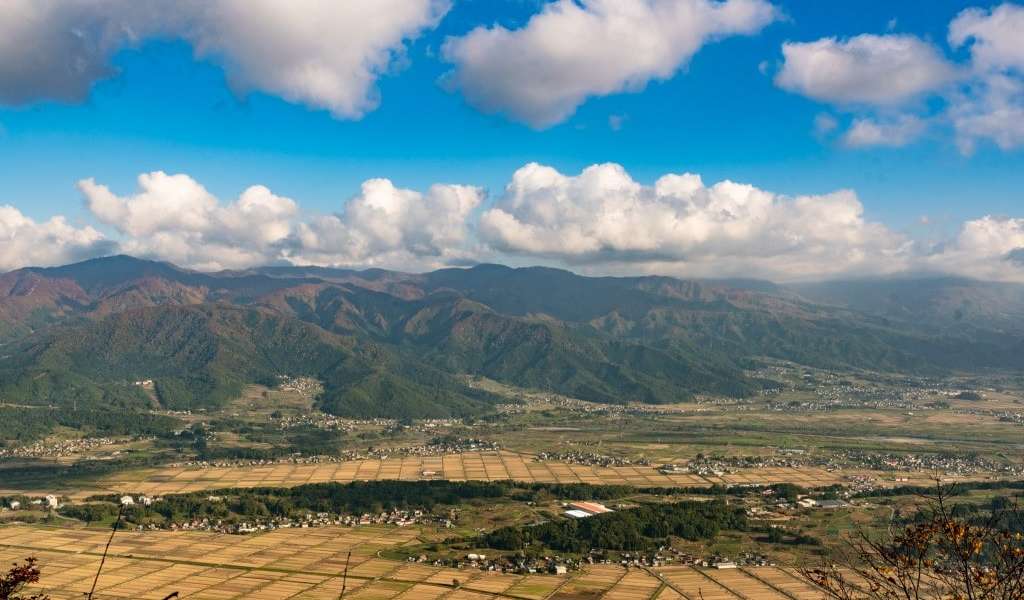
Section 3 of the trail - View of Shinano-Taira from Mt Kuroiwa
What are some local culinary specialities/events in the area?
In terms of speciality foods, the area has a variety of excellent dishes that take advantage of the region's wonderful local produce. One local speciality is imonamasu, a potato dish made from potatoes grown in Iiyama (which is a city just off the trail in Nagano). This dish has been served on ceremonial occasions since the Edo Period (1603 - 1867) and sees the potatoes cooked with the starch removed, so they have a crispy texture.
For those who like sake , the region is excellent for this too! Iiyama has two historical sake breweries, the Tanakaya Sake Brewery and the Kadoguchi Sake Brewery. The former produces Mizuo sake, a type of sake that's been crafted to showcase the water purity of the region, while the latter has a type of sake known as Hokko Masamune, made from Nagano-produced rice and is known for its dry and refreshing taste.
Banana boats are another regional speciality and a great post-hike treat! Banana boats are sponge cakes filled with bananas and whipped cream. Each store in Iiyama has its own unique way of making this local treat, so we suggest store hopping and trying a few varieties.
The region is also home to several spectacular seasonal events. In spring, there’s the Iiyama Nanohana Festival (nanohana is Japanese for rapeseed flowers), which has live performances, food stalls, walking tours and spectacular views of rolling yellow nanohana-blossom-carpeted fields backdropped by snow-capped peaks and crisp, clear blue skies.
Then, in winter, Restaurant Kamakura Village comes to life. Here, visitors can enjoy a nabe (hot pot) filled with locally grown vegetables like cabbage and mushrooms inside a kamakura, an igloo-like snow house. It's a novel way to enjoy the region's excellent local produce and architectural ingenuity.
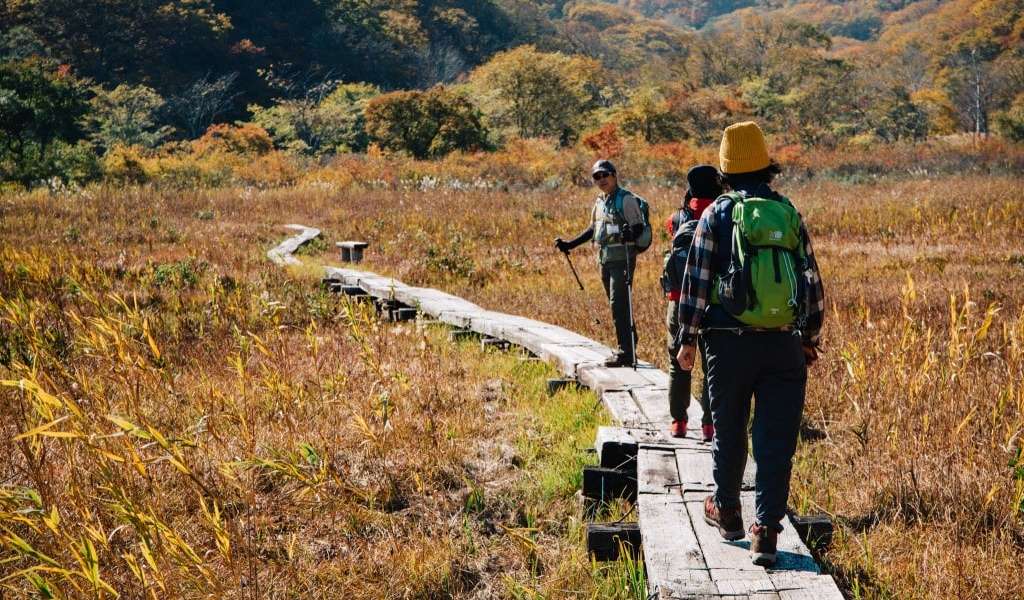
Numanohara Wetland in autumn
What accommodation is available along the Shinetsu Trail?
There are plenty of accommodation options for visitors walking the trail. Where you stay will depend largely on what part of the trail you want to explore. Here's a rundown of some of the options:
- Madarao Kogen Hotel : A popular ski lodge in winter and a lush natural retreat in the warmer months, this hotel in the Madarao Kogen Plateau area boasts an onsen (hot spring), a snack and souvenir store and an in-house restaurant.
- Inn and Soba Restaurant Maroudo : Also located in the Madarao Kogen Plateau area, this cabin-style accommodation features an onsen and an on-site restaurant serving up cosy home-style meals.
- Hunters Gate : Perfect for exploring the Togari Onsen Area in winter, this ski-in, ski-out lodge can accommodate between six and 24 people.
- Nabekurakogen Mori-no-Ie : For those exploring the Nabekura Plateau Area, this forest house is a cute option. Here, guests can stay in cabins surrounded by nature and partake in nature-focused activities like forest therapy and food experiences.
For more information on accommodation, you can find lodges affiliated with the Shinetsu Trail here .
Is it possible to do the trail yourself or do you need a hiking guide/to join a tour group?
If you're familiar with mountain hiking, then you can technically get around by yourself without a guide, but you'll only be getting half of the experience.
To learn about the history of this region, the flora of the snow country and the satoyama of Japan, we recommend that you arrange for a guide for at least one day.
Another benefit of going with a guide is that several companies in Australia provide package tours, including guide and baggage transfer services. That way, you can enjoy trekking and not have to worry about the logistics. Plus, you’ll have more time to take in the beautiful scenery!
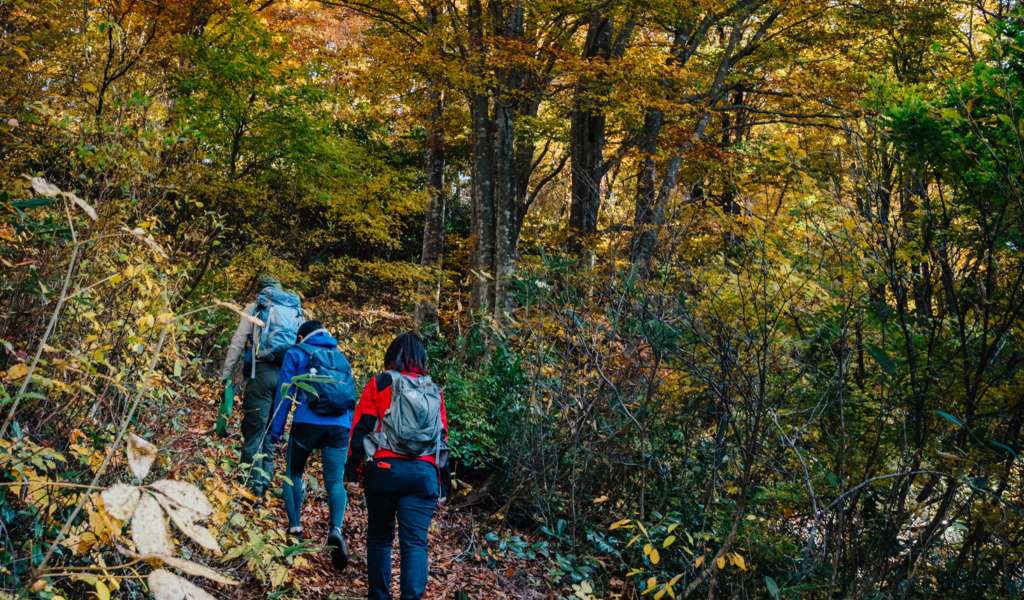
Section 3 - Under the beech trees
How to Get There
Sitting on the border of Nagano and Niigata Prefectures, the Shinetsu Trail is easily accessed via public transport. From Tokyo, it takes around 2 hours by Hokuriku Shinkansen to get to Iiyama Station, the closest station to the southern end of the trail. From here, you can catch a 30-minute taxi to Mt Madarao where the trail starts. Alternatively, you can catch a bus from the station - the Madarao bus line has various stops that visit different sections of the trail.
To start from the eastern point of the trail, take the Joetsu Shinkansen to Echigo Yuzawa Station. If travelling from Osaka or Kyoto, take the Limited Express Thunderbird to Kanazawa then transfer to the Hokuriku Shinkansen to Iiyama Station.



















































